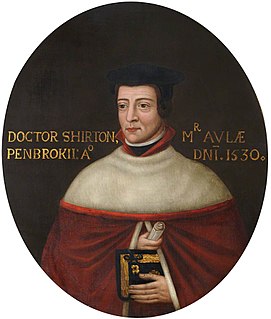Related Research Articles
John Taylor, English classical scholar, was born at Shrewsbury in Shropshire, England.
Christopher Urswick (1448–1522) was a priest and confessor of Margaret Beaufort. He was Rector of Puttenham, Hertfordshire, and later Dean of Windsor. Urswick is thought to have acted as a go-between in the plotting to place her son Henry VII of England on the throne.

Cuthbert Tunstall was an English Scholastic, church leader, diplomat, administrator and royal adviser. He served as Prince-Bishop of Durham during the reigns of Henry VIII, Edward VI, Mary I and Elizabeth I.
John Taylor was Master of the Rolls of the Court of Chancery from 1527 to 1534, following a successful career as a priest and civil servant.
Richard Sampson was an English clergyman and composer of sacred music, who was Anglican bishop of Chichester and subsequently of Coventry and Lichfield.

Richard Mitford was an English bishop of Chichester from 17 November 1389, consecrated on 10 April 1390, and then bishop of Salisbury. He was translated to the see of Salisbury on 25 October 1395.

Godfrey Goldsborough was a Church of England clergyman and bishop of Gloucester from 1598-1604. He was educated at Trinity College, Cambridge. He also served as a Prebendary of Worcester.
Richard Nykke became bishop of Norwich under Pope Alexander VI in 1515. Norwich at this time was the second-largest conurbation in England, after London.

Robert Shorton was an English churchman and academic, first Master of St John's College, Cambridge and Archdeacon of Bath.
William Warham was a late-medieval English ecclesiastical administrator who was Archdeacon of Canterbury from c. 1505 to 1532 during the archiepiscopate of his uncle William Warham, Archbishop of Canterbury.
Thomas Fastolf, sometimes spelt Fastolfe, was an English canon lawyer and Bishop of St David's from 1352 until his death.
John Pollard was a 16th-century Archdeacon of Wiltshire, Archdeacon of Cornwall, Archdeacon of Barnstaple and Archdeacon of Totnes.
The Venerable William Robinson DD was Archdeacon of Nottingham.
James Denton was a Canon of Windsor from 1509 to 1533 Archdeacon of Cleveland from 1523 - 1533, and Dean of Lichfield from 1523 to 1532.
Richard Kingston was a Canon of Windsor from 1400 to 1402 and the Dean of Windsor from 1402 to 1418.
Richard Rawson was Archdeacon of Essex from 1503 and a Canon of Windsor from 1523 to 1543 He was the son of Richard Rawson, a merchant of London and his wife Isabella Craford, and a younger brother of John Rawson, 1st Viscount Clontarf, Lord Treasurer of Ireland. He received his Bachelor of Canon Law at Cambridge in 1490, followed by a presumed doctorate from the University of Bologna.
Christopher Plummer was a Canon of Windsor from 1513 - 1535. He was attainted and deprived in 1535.
Simon Symonds M.A. was a Canon of Windsor from 1535–1551.
The Venerable John Wardroper, DCL was an English clergyman.
William Fleshmonger(? -1541/42), the son of a Winchester College tenant, was born in Hambledon, Hampshire. He was a Doctor of Canon Law and Dean of Chichester during the turmoil of the English Reformation.
References
- ↑
 One or more of the preceding sentences incorporates text from a publication now in the public domain : "DNB name". Dictionary of National Biography . London: Smith, Elder & Co. 1885–1900.
One or more of the preceding sentences incorporates text from a publication now in the public domain : "DNB name". Dictionary of National Biography . London: Smith, Elder & Co. 1885–1900. - ↑ "Ashton, Hugh (ASTN507H)". A Cambridge Alumni Database. University of Cambridge.
. Dictionary of National Biography . London: Smith, Elder & Co. 1885–1900.